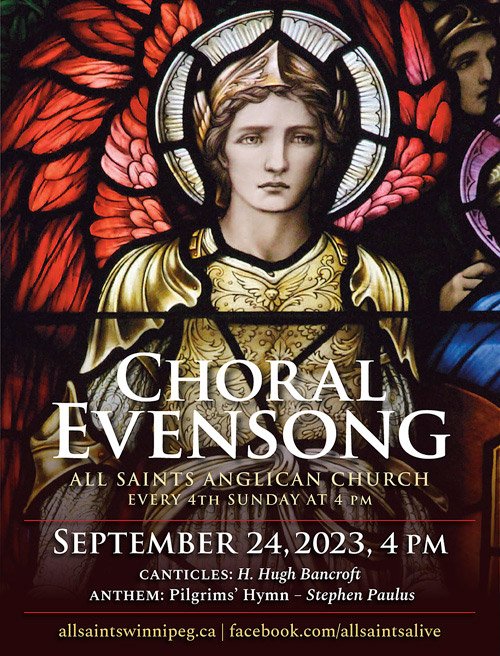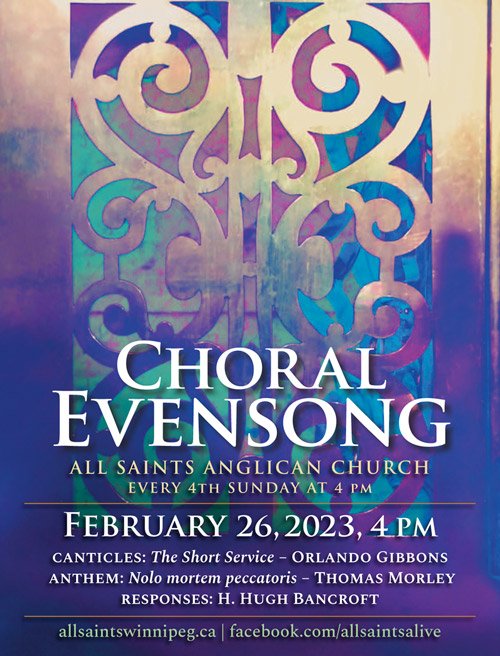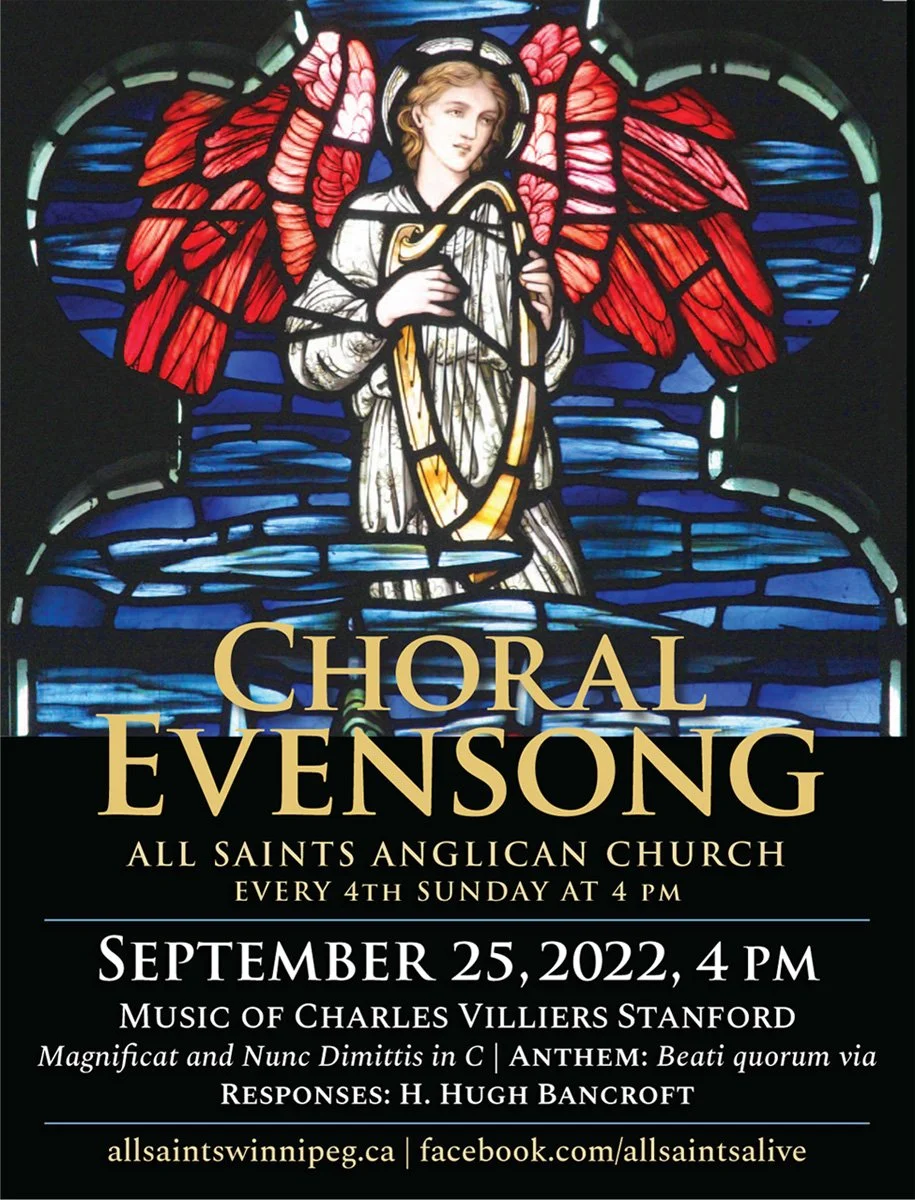
Upcoming Calendar Events

Purcell’s Te Deum - Choral Evensong with Orchestra and Soloists
To help celebrate All Saints’ 140 years of ministry in Winnipeg, our Evensong on October 22 will feature a performance of Henry Purcell’s Te Deum in D. Purcell composed this brilliant setting of the Te Deum (We praise Thee, O God) for the St. Cecilia Day celebrations, November 22, 1694 in St Bride’s Church in Fleet Street. This elaborate setting of the text was the first of its kind in English Church music, and served as a model for Handel’s setting of the same text 20 years later. Composed in a style that was vastly different than the very conservative liturgical settings at the time, Purcell's setting presented a very modern, even flamboyant verse anthem style, scored not only for treble and adult choirs, soloists, strings and continuo, but also for trumpets. It caused such a sensation, that Baroque composer Thomas Tudway, who was in attendance, wrote:
“There is in this Te Deum, such a glorious representation, of ye Heavenly Choirs, of Cherubins, & Seraphins, falling down before ye Throne & singing Holy, Holy, Holy &c As hath not been Equall’d, by any Foreigner, or Other; He makes ye representation thus; he brings in ye treble voices, or Choristers, singing, To thee Cherubins, & Seraphins, continually do cry; and then ye Great Organ, Trumpets, the Choirs & at least thirty or forty instruments besides, all Joine, in most excellent Harmony, & Accord; The Choirs singing only, ye word Holy; Then all Pause, and ye Choristers repeat again, continually do cry; Then, ye whole Copia Sonorum, of voice, & instruments, Joine again, & sing Holy; this is done 3 times upon ye word Holy only, changeing ev’ry time ye Key, & accords; then they proceed altogether in Chorus, wth, Heavn’n & Earth are full of ye Majesty of thy glory; This most beautifull, & sublime representation, I dare challenge, all ye Orators, Poets, Painters &c of any Age whatsoever, to form so lively an Idea, of Choirs of Angels singing, & paying their Adorations.”
While our performance will be slightly less grand, with a modest orchestra, it should none the less be a sublime presentation.
Please join us for Evensong on the fourth Sunday of most months. This meditative 45 minute service uses the traditional language from the Book of Common Prayer and features glorious music from our choir. A casual reception follows.
Finish your weekend on a relaxing note, or start your evening off with a refreshing musical experience.

Choral Evensong
Canticles: H. Hugh Bancroft
Anthem: Pilgrim’s Hymn - Stephen Paulus
Please join us for Evensong on September 24th, and on the fourth Sunday of most months. This meditative 45 minute service uses the traditional language from the Book of Common Prayer and features glorious music from our choir. A casual reception follows.
Finish your weekend on a relaxing note, or start your evening off with a refreshing musical experience.

Bach Easter Oratorio
Bach Easter Oratorio
All Saints Choir with Soloists and Orchestra
Admission by Donation
This month, instead of our usual Choral Evensong, join us for this spectacula performance of J.S. Bach’s Easter Oratorio. A casual reception follows.
The Easter Oratorio by Johann Sebastian Bach was composed in 1725 in Leipzig, in the third year of Bach’s tenure at the St. Thomas Church. Like so many of Bach’s compositions, this was also a “work in progress,” receiving revisions in 1735, when he first names it an oratorio, and then again sometime in the 1740s. Revisions included changes in scoring, such as replacing the solo violin with the solo flute in the soprano aria, as well as adding more choral work.
Among the over two hundred cantatas and oratorios composed by Bach, the Easter Oratorio assumes a unique position. It is the only church music composition by Bach in which a narrative is presented implicitly, that is, without a narrator or evangelist. While his cantatas as a rule focus on a theme, or a chorale, his oratorios, like the Christmas oratorio, the Ascension oratorio, or the Passions, focus on a recitation of the biblical narrative, normally in the voice of a tenor evangelist.
The Easter Oratorio opens with two instrumental movements, most likely remnants of a concerto written in earlier years when Bach was in Cöthen. These two movements reflect not only the joy of the resurrection, but also, as portrayed in the heavy-hearted second movement, with the wonderful solo oboe line, the sorrow over the death of Jesus, which still hung heavily over his followers, before they grasped the reality of his resurrection.
In the third movement we encounter the disciples Peter (the tenor) and John (the bass) rushing to the tomb. In the original 1725 version, this movement was cast entirely as a duet. In his final version, Bach arranged the opening of the duet for full chorus, retaining the duet only for the middle section of the movement. Closely related to the opening movement, this third movement might very well have been the third movement of an original instrumental composition. Quite possibly it was the ascending running motifs that inspired Bach to use this music for an Easter Oratorio, a perfect picture of the resurrection.
The story continues in the following recitative at the tomb of Jesus, where Peter and John meet Mary the mother of James (soprano) and Mary Magdalene (alto), whose intention to salve the body with spices and myrrh had now become pointless. In the following soprano aria, Mary the mother of James then reflects that those spices could now be replaced with the laurel wreath of victory. But it is an aria of mixed emotions, deeply reflective and not fully consumed with joy and elation: she acknowledges that Jesus is no longer in the tomb, but of course, she has not yet met the risen Christ.
And so the story continues in the following recitative involving Mary Magdalene, Peter, and John. Mary informs the questioning men, that an angel brought the good news that Jesus has risen from the dead. Upon finding Jesus’ empty shroud, Peter responds in the following aria, that his own death will now also only be a gentle sleep, and that he too can look forward to a resurrection. Again this aria is tinged with a note of sadness: Bach emphasizes this through his scoring–originally for two recorders–which was common for funeral music–one need only think of the opening of his funeral cantata Actus Tragicus. But it is also pastoral slumber music, in a similar vein to the well-known “Sheep may safely graze.” In fact, when Bach reused the music of the Easter Oratorio for a secular cantata, he set the words: “Lull yourselves to sleep, you satisfied sheep” to the music of this tenor aria.
The next recitative, set for the two Marys, picks up on the theme of longing to encounter the resurrected Christ, for, as Mary Magdalene exclaims in the following alto aria, without Jesus’ embrace, she will remain “orphaned and wretched.” But the tone of this aria is quite different–it is filled with confident joy in meeting the resurrected Saviour.
And so John proclaims in the last recitative, that Jesus has indeed been raised from the dead, and that all should join in a song of jubilation. In response the choir, which Bach identifies as the “chorus of believers,” then raises its song of joy and thanksgiving in the final chorus. And so the oratorio ends, not with a chorale, as was the norm with a cantata, but with a great chorus, in the spirit and form of an oratorio. A final chorale indeed follows, but it will be sung by the entire congregation at the conclusion of the service.

Choral Evensong
Canticles: Evening Service in G minor - Henry Purcell
Anthem: Sicut Cervus - Giovanni Da Palestrina
Responses: H. Hugh Bancroft
Please join us for Evensong on March 26th, and on the fourth Sunday of most months. This meditative 45 minute service uses the traditional language from the Book of Common Prayer and features glorious music from our choir. A casual reception follows.
Finish your weekend on a relaxing note, or start your evening off with a refreshing musical experience.

Choral Evensong
Canticles: The Short Service - Orlando Gibbons
Anthem: Nolo mortem peccatoris - Thomas Morley
Responses: H. Hugh Bancroft
Please join us for Evensong on February 26th, and on the fourth Sunday of most months. This meditative 45 minute service uses the traditional language from the Book of Common Prayer and features glorious music from our choir. A casual reception follows.
Finish your weekend on a relaxing note, or start your evening off with a refreshing musical experience.

Choral Evensong
Canticles: Magnificat and Nunc Dimitis in C - C.V. Stanford
Anthem: Beati quorum via - C.V. Stanford
Responses: H. Hugh Bancroft
Please join us for Evensong on January 22nd, and on the fourth Sunday of most months. This meditative 45 minute service uses the traditional language from the Book of Common Prayer and features glorious music from our choir. A casual reception follows.
Finish your weekend on a relaxing note, or start your evening off with a refreshing musical experience.
Click on image to start video

Choral Evensong
Canticles: The Short Service - Orlando Gibbons
Anthem: Prayer Before Sleep - Sid Robinovitch
Responses: H. Hugh Bancroft
Please join us for Evensong on October 23rd, and on the fourth Sunday of every month. This meditative 45 minute service uses the traditional language from the Book of Common Prayer and features glorious music from our choir. A casual reception follows.
Finish your weekend on a relaxing note, or start your evening off with a refreshing musical experience.
Click on image to start video

Choral Evensong
Music of Charles Villiers Stanford
Magnificat and Nunc Dimittis in C
Anthem: Beati Quorum Via
Responses: Hugh Bancroft

Advent Procession with Carols - November 28, 2021
Please join us for the 68th Annual Advent Procession with Carols
In the ancient liturgies of the Christian Church, the Advent Offices mark a vivid presentation in word and song of the Coming of our Lord. We prepare our hearts for the coming of Christ into our world and into our lives by remembering the prophesy of redemption, the announcement of the Messiah’s birth, and the promise of Jesus Christ’s return in glory. Throughout this service the choir moves in procession from west to east, from “darkness” to “light.” First, from the west, the Matins Responsory of First Advent announces the hope of the Messiah, followed by the hymn of St. Ambrose, Veni Redemptor gentium. As the procession passes into the choir, prophetic lections alternate with hymns and carols. At the Annunciation, when the Gospel replaces the Prophets, the choir sings from the Lady Chapel. After St. John’s synopsis of the Incarnation, we focus on the Second Coming of Christ with lections from the Epistles. As those of old looked forward to the arrival of the Messiah, so too let us participate in this anticipation of our Redeemer’s past, present, and future Advent.
Carols and motets by:
R. Vaughan Williams
Thomas Lavoy
David MacMillan
Healey Willan
Daniel Wiebe
Anton Bruckner
John Tavener
Stanford Scriven
Paul Manz
with organ voluntaries by J. S. Bach
Please try to arrive early to allow for Covid safety protocols. Double vaccination, social distancing and masks are required.
Parking information and more can be found on our Contact Us page.






